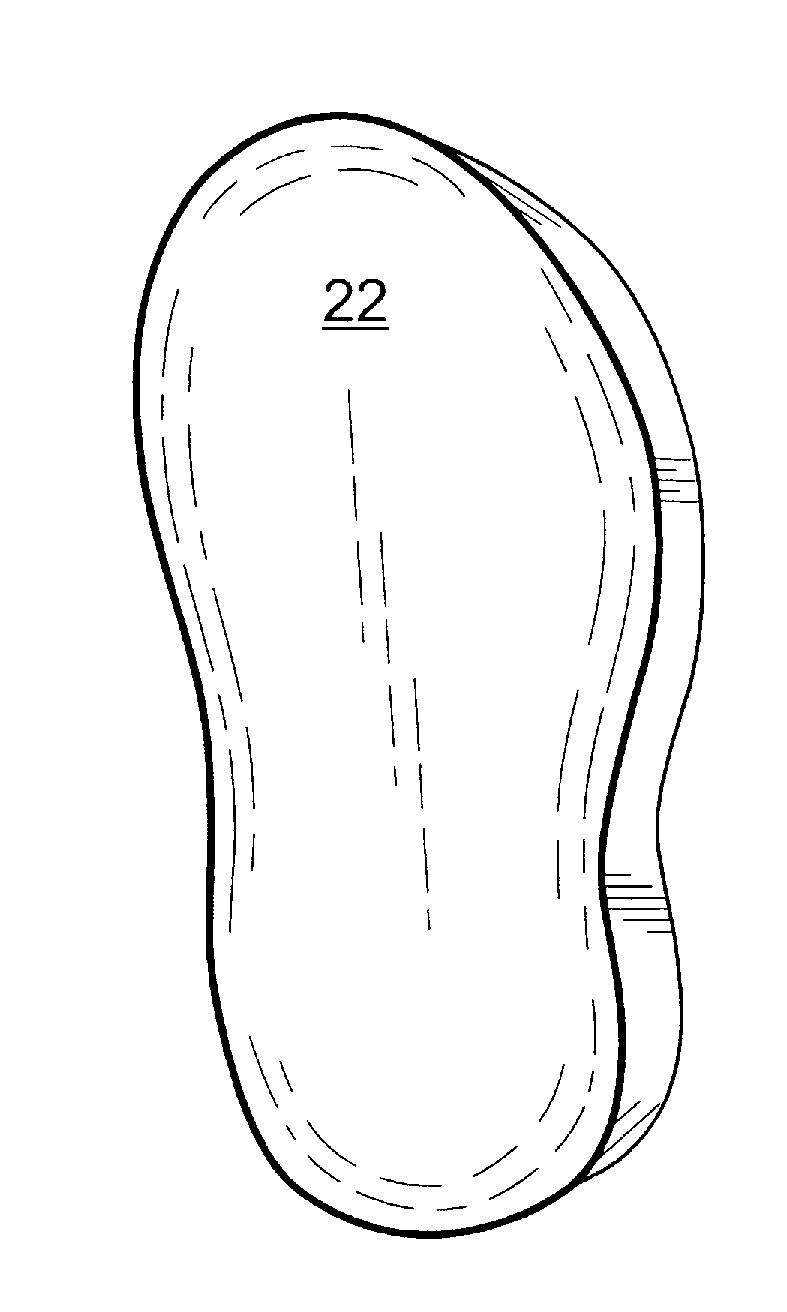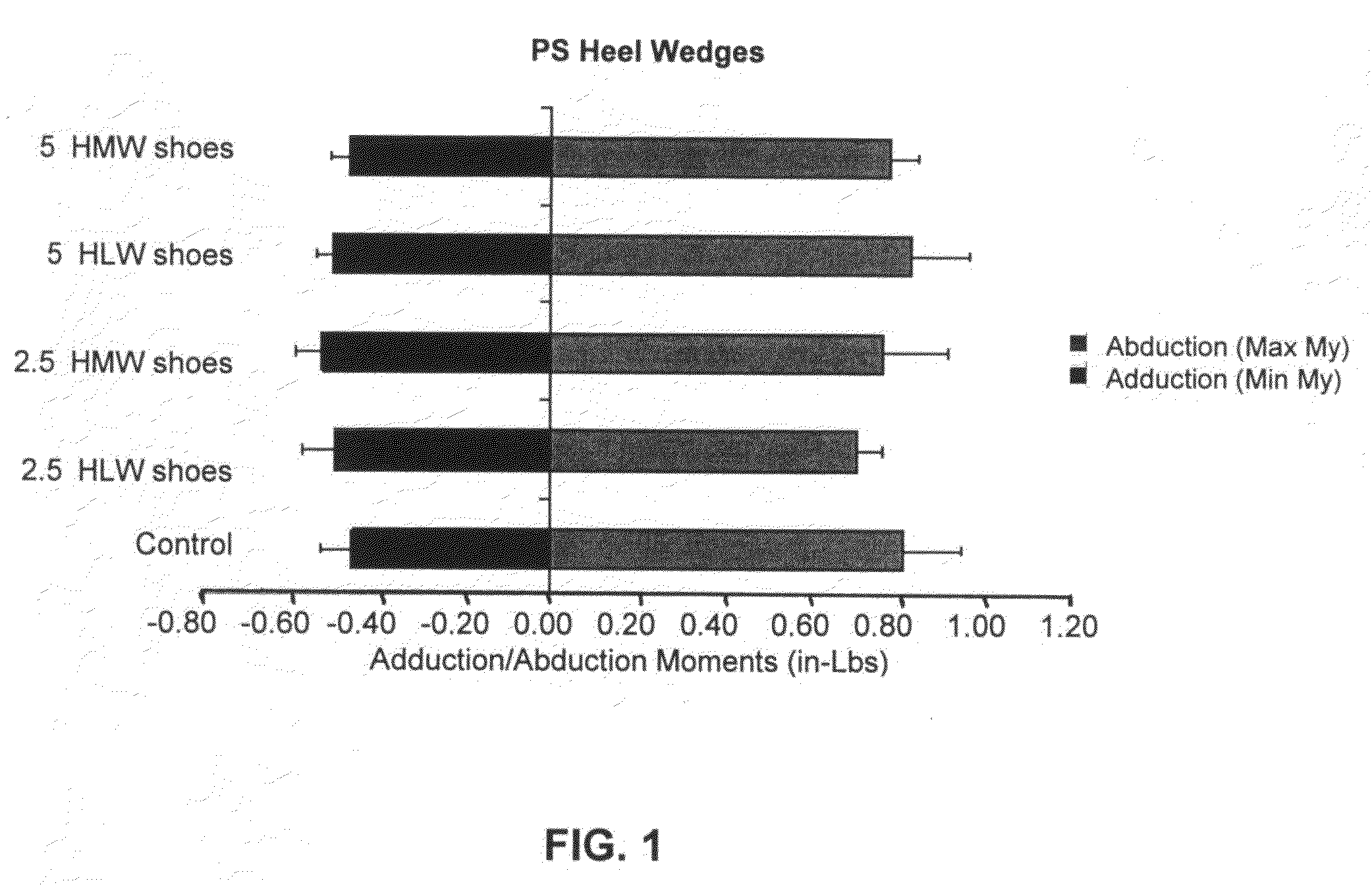Prevention, Treatment and Rehabilitation of Injuries and Medical Conditions Affecting Weight-Bearing Joints Using Insoles that Alter Axial Forces
a technology of axial force and insole, applied in the field of orthotics, can solve the problems of unreliable testing techniques employed in traditional studies, unreliable heel wedges, and ineffective treatment of weight-bearing joints, and achieve the effect of dispersing forces
- Summary
- Abstract
- Description
- Claims
- Application Information
AI Technical Summary
Benefits of technology
Problems solved by technology
Method used
Image
Examples
example 1
Construction and Compression Test of EVA Wedged Insoles
[0123]Wedge insoles were tested for compression properties with a HFG-45 hand-held force gauge [(CE) Transducer Techniques, Temecula, Calif.] to ensure they retained a wedged configuration even during compression
[0124]A 5-degree (relative to the bottom of the insole, measured from the thicker side to the thinner side) cushioned wedge insole was prepared from EVA. The thicker side of the insole measured about 12 mm in height, while the thinner side of the insole measured 4 mm. Under a force of 25-26 ft-lb (foot-pound) the 12 mm thick side reached maximum compression (to 5 mm). The 4 mm thick side reached maximum compression (to 1 mm) under a compression force of 20-26 ft-lb. As such, the EVA wedged insole was able to retain is generally wedged configuration during compression.
[0125]A 2.5-degree (measured from the thicker side to the thinner side) cushioned wedged insole was prepared from EVA. The thicker side of the insole measur...
example 2
Physical Properties of PORON Neutral Balance Insoles in Comparison to Cushioned Wedge Insoles
[0127]Testing of the PORON material in a 4 mm-thick neutral balance insole was performed as follows. Maximal compaction of the 4 mm height is 1 mm. The force to maximal compaction is 9-14 ft-lb. Thus, in the neutral balance insole (of PORON), compaction stops at 1 mm depth. This endpoint is achieved by manually applying force of 9-14 ft-lb to an unconstrained insole.
[0128]In contrast, EVA cushioned wedged insoles force to compaction varied with the depth of the material. The 5 degree slope on its highest edge required more force to compaction than lesser depths of the same material. This material testing to maximum compaction is relevant as it is correlated with E-knee direct evidence results.
example 3
Cushioned Wedged Insoles Shift Forces across the Medial Compartment of the Knee
[0129]Testing at the Shiley Center for Orthopedic Research and Education (La Jolla, Calif.) on patients with pressure sensing total knee replacement implants demonstrated the various peak mechanical forces across the knee during participation in various activities. When standing, the force across the knee joint is 3.5 times the body weight. When walking, force across the knee is 2.5 times the body weight at foot strike. These forces were also measured during a variety of sports, including golf. When a 75 year old swings a golf club at 65 miles per hour (relatively slow speed), the force on the back knee reaches 3.5 times body weight at impact while the force on the front knee reaches 4.5 times body weight.
[0130]The peak forces on the knee were measured compared to unloader braces (OSSUR) and wedged insoles, both lateral wedges and medial wedges. No change in forces was measured when using the unloader bra...
PUM
 Login to View More
Login to View More Abstract
Description
Claims
Application Information
 Login to View More
Login to View More - R&D
- Intellectual Property
- Life Sciences
- Materials
- Tech Scout
- Unparalleled Data Quality
- Higher Quality Content
- 60% Fewer Hallucinations
Browse by: Latest US Patents, China's latest patents, Technical Efficacy Thesaurus, Application Domain, Technology Topic, Popular Technical Reports.
© 2025 PatSnap. All rights reserved.Legal|Privacy policy|Modern Slavery Act Transparency Statement|Sitemap|About US| Contact US: help@patsnap.com



